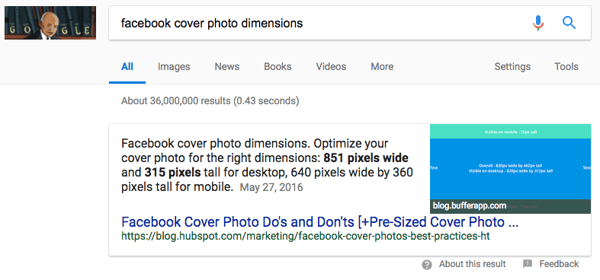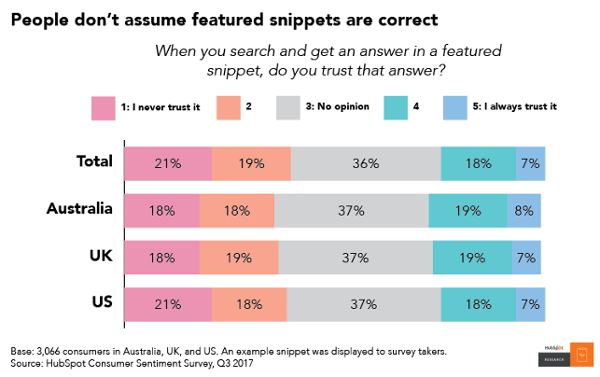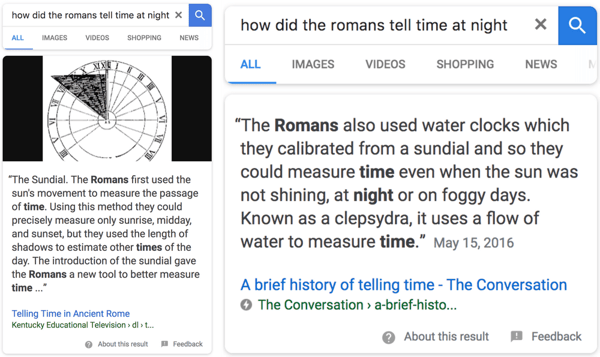Friends, I have a confession to make.
There are moments when I obsess over Google's algorithm in the same way that certain movie characters might obsess about their exes.
I mean, we all do, right? After all, just look at how much my colleagues and I discussed it right here on the Marketing Blog. Here's what Google did this month. Here's what Google's doing next. Here's how search is changing. Here's how it works.
And now, Google itself has decided to carry its own torch on that last part -- how it works.
Most recently, Danny Sullivan, Google's public liaison for search, published a comprehensive blog post on the search engine's featured snippets: the concise responses to search queries that appear above general results.
The post dives into what a featured snippet might look like depending on how a search was conducted (like voice or mobile), or what information is being requested.
Sullivan also acknowledged where Google has gone wrong with featured snippets, and how it plans to approach them moving forward.
Naturally, my team had our own take.
What Is Google's Featured Snippet?
A featured snippet is a concise response to a Google search query. It's displayed on top of the general results, and also includes the page's publication date, title, and URL.
Featured snippets drive traffic -- but not always.
When featured snippets first began appearing in Google search results in January 2014, it immediately caused chatter among marketers and SEOs alike. And as Sullivan acknowledged in his blog post, many were concerned that traffic would drop -- as a result, for example, of users finding the information they needed right away from the featured snippets, therefore not clicking to visit any sites.
Then, there was the issue of how this would change the concept of "position one" on the search results page (SERP) -- would anything below the featured snippet even matter anymore?
And as Sullivan noted, Google found that the featured snippets did, in fact, drive traffic -- to the sources of information within them. Position one, it turned out, might become obsolete after all.
Simply put, "you don’t get as much organic traffic from being in position one when there's a snipped above your search result," says HubSpot's SEO Associate Marketing Manager Padraig O'Connor. "They take clicks away from the search results beneath them, which is why businesses can’t afford to not optimize their content for featured snippets."
Back in December, we wrote about our own research on just how much featured snippets eat into blog traffic. Consider that on SERPs with no featured snippet, we found that the first result can expect to bring in about 33% of the total clicks. The second result accounts for 18%, and the rest, 11% or under.
But when the SERP does feature a snippet, we found that it does receive a high ratio of clicks -- about 50%, versus the 33% received by the position one result on SERPs without one. That means that when there's a featured snippet, it decreases clicks on the remaining results below it to the point that some of the top 10 become nearly obsolete.
But the featured snippet doesn't always drive clicks. Remember that Google itself noted predictions that once users saw the information they were seeking in the featured snippet, they might exit and move on. According to O'Connor, those predictions were accurate.
“Sometimes people find the answer they wanted from the snippet and don’t click any result. We know this from experiments our SEO team ran here at HubSpot," he explains, noting a test in which we found that our post on Facebook cover photo tips appeared as the featured snippet in results for the query, "Facebook cover photo dimensions" -- but didn't drive clicks.

"As a result," O'Connor says, "it’s important for marketers to add a 'hook' in their featured snippets that makes people want to click through."
Google doesn't always get the featured snippet right -- which makes it even more important.
The introduction of featured snippets, like many of the other ways Google has changed its algorithm, was meant to solve for the user.
"We believe this format will help people more easily discover what they’re seeking," Sullivan wrote in his blog post, "both from the description and when they click on the link to read the page itself."
And while that path was seemingly paved with good intentions -- Google didn't always get it right. In fact, our research found that only 7% of people actually trust featured snippets -- and that 21% never trust them.

My own, lighthearted research supported these findings, like when I searched for, "Why are dogs the best?"

While the featured snippet gives me some nice information about the history of dogs becoming domestication, it doesn't really tell me anything about what, specifically, makes them such great little creatures.
Four-legged friends aside, Sullivan admitted that Google itself has realized some of its less-than-accurate featured snippet results, using the query “how did the Romans tell time at night” as an example.

Source: Google
Notice that the query specifically asks how this works at night -- when a sundial, which is the method indicated in the featured snippet on the left above, "would be useless," as Sullivan put it.
But Google is investing efforts into optimizing featured snippets results to reflect accurate information that better aligns with the user's full query, which is illustrated by the newer (correct) featured snippet on the right in the image above.
That Google is making such an investment, says O'Connor, should give marketers pause -- and the realization that Google is only placing a growing amount of importance on the featured snippet on SERPs.
"This highlights that Google is doubling down on featured snippets," he explains, "and marketers need to optimize their content if they want to be featured."
Voice search is going to shape the way this works.
When Sullivan explained the reasoning behind Google's introduction of featured snippets, he made a short, but extremely important point:
"It’s especially helpful for those on mobile or searching by voice."
In May 2016, Google CEO Sundar Pichai noted in his I/O keynote that 20% of its mobile app and Android device searches were executed by voice -- a figure that has likely only increased in the roughly 20 months since it was first unveiled, especially when you consider the near-saturation of the voice assistant device market.
In other words, the way people are searching is evolving -- quickly. A growing number of people are becoming personal assistant device owners, and therefore executing a larger number of voice search queries. Just have a look at this more recent data from Google:

So, what does this mean? With more people seeking information by voice -- and with Google Home, for example, delivering that information by way of a spoken featured snippet -- marketers will have to consider these multiple levels and methods of search when it comes to optimizing their content.
Of course, optimizing for voice search won't result in more clicks. Google Home does typically cite the result of the featured snippet in a spoken result, and there are options to learn more through its app, but most users will not get to the point of clicking when seeking information by voice.
Nonetheless, this continued evolution of search -- and Google's growing emphasis on the featured snippet -- does have crucial implications for search marketers and the way content is optimized.
"With the increase in new features in the search results page, most notably Featured Snippets, and the increased importance of voice search, the way that marketers think about optimizing content for search has shifted a lot," says Matt Barby, HubSpot's Director of Acquisition. "It's tough to predict how Google will ultimately enable searchers to consume that content, so creators have to optimize for multiple outcomes at the same time."
Sullivan's blog post, however, was just one in what Google says will be a series on how its search engine works, so it's possible that it will continue to shed light on its plans for the delivery of search results -- by mobile, desktop, or voice.
But in the meantime, here's a primer on how to get started with featured snippet optimization, which contains even more information on just why it's so important -- and why we all have to adapt.
"It's the wild west here," says HubSpot SEO Manager Victor Pan. "Businesses with experimentation and agility in their DNA will be the ones that win."
Featured image source: Google
from Marketing https://blog.hubspot.com/marketing/how-featured-snippets-work
No comments:
Post a Comment